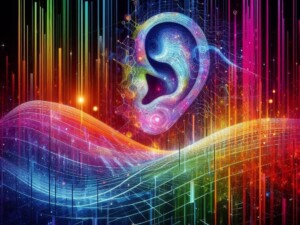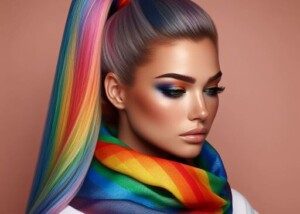I’ve been hearing color since I could remember; Autistics are three times more likely than neurotypicals to have synesthesia.
Synesthesia is a fascinating phenomenon in which one sensory experience triggers another, or to put another way, there’s an overlap of sensory experiences.
If you don’t have chromesthesia, which is the type of synesthesia in which one hears colors, then you likely struggle to imagine this experience.
However, some synesthetes (people with synesthesia), taste colors, or they may even taste shapes or feel sounds, among many other possible sensory overlaps. And I myself absolutely cannot imagine these experiences!
Understanding Synesthesia

©Lorra Garrick
Synesthesia occurs when stimulation of one sensory or cognitive pathway leads to involuntary experiences in a second pathway.
For instance, individuals with sound-color synesthesia perceive specific colors upon hearing particular sounds, such as music or spoken words.
In my case, my chromesthesia comes on mighty strong when I hear numbers, or single names or isolated words.
I have it to a lesser extent when I listen to music, particularly my favorite symphonies.
I also have, to a lesser extent, a triggering of abstract visuals or patterns (always with the same colors) when I listen to music as well as hear various sounds.
The underlying mechanisms of synesthesia are still being unraveled, but it’s believed to involve atypical neural connections and heightened cross-activation between brain regions responsible for processing different sensory modalities.
Atypical is the key word here, and you can’t get more atypical than being on the Autism Spectrum!
Exploring the Autism-Synesthesia Connection
While synesthesia is not exclusive to individuals with autism, several studies have suggested a higher prevalence of synesthesia among autistic individuals compared to the general population.
One hypothesis proposes that the atypical neural connectivity seen in ASD and synesthesia could contribute to the co-occurrence of autism and synesthesia.
Additionally, both conditions involve altered sensory processing, albeit manifesting in distinct ways.
Research Evidence
A study published in the journal Autism in 2013 examined the prevalence of synesthesia in autistic individuals.
The researchers found a significantly higher occurrence of synesthesia among autistic participants compared to neurotypical controls.
Interestingly, they also observed that individuals with both autism and synesthesia tended to have more pronounced sensory sensitivities and repetitive behaviors compared to those with autism alone.
Further supporting the link between autism and synesthesia, a study published in the journal Molecular Autism in 2017 investigated the genetic overlap between the two conditions.
The researchers identified common genetic variants associated with both autism and synesthesia, suggesting shared underlying biological mechanisms.
Moreover, neuroimaging studies have provided insights into the neural basis of synesthesia in autism.
Functional magnetic resonance imaging (fMRI) studies have revealed differences in brain activation patterns during sensory processing tasks in autistic individuals with synesthesia compared to those without synesthesia.
These differences suggest that the co-occurrence of autism and synesthesia may be associated with distinct neural signatures.
The Role of Sensory Processing
Both autism and synesthesia involve alterations in sensory processing, though in different ways.
In autism, sensory sensitivities are commonly observed, with individuals experiencing either heightened or diminished sensitivity to sensory stimuli such as light, sound, touch or taste.
Synesthesia, on the other hand, represents a unique form of sensory perception where stimuli from one modality evoke sensations in another modality.
It’s plausible that the sensory processing differences observed in autism could predispose people to develop synesthetic experiences.
For example, heightened sensitivity to auditory stimuli in autism may increase the likelihood of sound-color associations forming in the brain, leading to the development of sound-color synesthesia.
Studies have revealed that on average, synesthesia shows up among 18.9% of Autistics, and comes in at 7.2% for the general population.
The synesthetic experience, as reported by synesthetes, is prevalent since as early as they can remember – and is totally involuntary, as well as very consistent in terms of perception.
For example, no matter what, I always hear “17” as yellow-gold and “19” as light translucent green.
 Lorra Garrick has been covering medical and fitness topics for many years, having written thousands of articles for print magazines and websites, including as a ghostwriter. She’s also a former ACE-certified personal trainer. In 2022 she received a diagnosis of Level 1 Autism Spectrum Disorder.
Lorra Garrick has been covering medical and fitness topics for many years, having written thousands of articles for print magazines and websites, including as a ghostwriter. She’s also a former ACE-certified personal trainer. In 2022 she received a diagnosis of Level 1 Autism Spectrum Disorder.
.










































